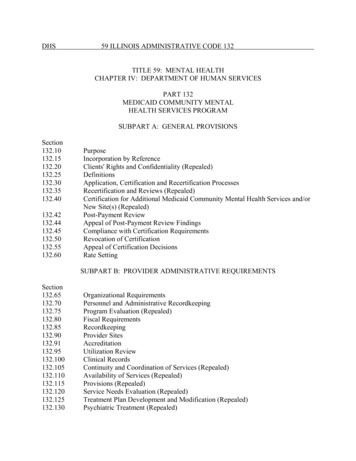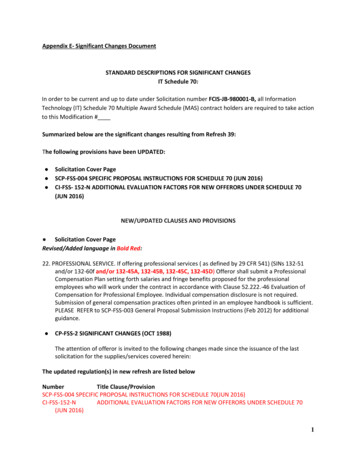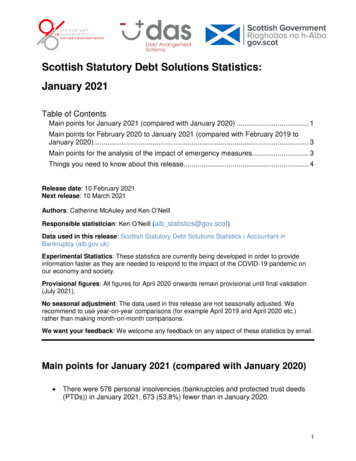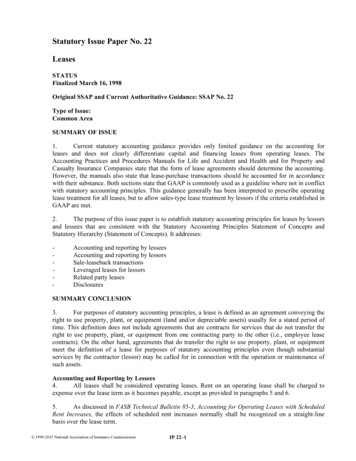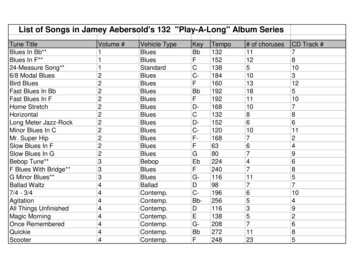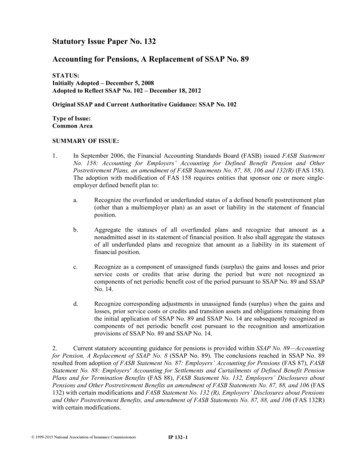
Transcription
Statutory Issue Paper No. 132Accounting for Pensions, A Replacement of SSAP No. 89STATUS:Initially Adopted – December 5, 2008Adopted to Reflect SSAP No. 102 – December 18, 2012Original SSAP and Current Authoritative Guidance: SSAP No. 102Type of Issue:Common AreaSUMMARY OF ISSUE:1.In September 2006, the Financial Accounting Standards Board (FASB) issued FASB StatementNo. 158: Accounting for Employers’ Accounting for Defined Benefit Pension and OtherPostretirement Plans, an amendment of FASB Statements No. 87, 88, 106 and 132(R) (FAS 158).The adoption with modification of FAS 158 requires entities that sponsor one or more singleemployer defined benefit plan to:a.Recognize the overfunded or underfunded status of a defined benefit postretirement plan(other than a multiemployer plan) as an asset or liability in the statement of financialposition.b.Aggregate the statuses of all overfunded plans and recognize that amount as anonadmitted asset in its statement of financial position. It also shall aggregate the statusesof all underfunded plans and recognize that amount as a liability in its statement offinancial position.c.Recognize as a component of unassigned funds (surplus) the gains and losses and priorservice costs or credits that arise during the period but were not recognized ascomponents of net periodic benefit cost of the period pursuant to SSAP No. 89 and SSAPNo. 14.d.Recognize corresponding adjustments in unassigned funds (surplus) when the gains andlosses, prior service costs or credits and transition assets and obligations remaining fromthe initial application of SSAP No. 89 and SSAP No. 14 are subsequently recognized ascomponents of net periodic benefit cost pursuant to the recognition and amortizationprovisions of SSAP No. 89 and SSAP No. 14.2.Current statutory accounting guidance for pensions is provided within SSAP No. 89—Accountingfor Pension, A Replacement of SSAP No. 8 (SSAP No. 89). The conclusions reached in SSAP No. 89resulted from adoption of FASB Statement No. 87: Employers’ Accounting for Pensions (FAS 87), FASBStatement No. 88: Employers' Accounting for Settlements and Curtailments of Defined Benefit PensionPlans and for Termination Benefits (FAS 88), FASB Statement No. 132, Employers’ Disclosures aboutPensions and Other Postretirement Benefits an amendment of FASB Statements No. 87, 88, and 106 (FAS132) with certain modifications and FASB Statement No. 132 (R), Employers’ Disclosures about Pensionsand Other Postretirement Benefits, and amendment of FASB Statements No. 87, 88, and 106 (FAS 132R)with certain modifications. 1999-2015 National Association of Insurance CommissionersIP 132–1
IP No. 132Issue Paper3.The purpose of this issue paper is to update statutory accounting principles for pensions,including both defined benefit plans and defined contribution plans. Consequently, this issue paper adoptsFAS 158 with modifications considered necessary for consistent statutory reporting. The result will be anew SSAP (SSAP No. 102) superseding SSAP No. 89.SCOPE OF STATEMENT4.This issue paper establishes financial accounting and reporting standards for an insurer that offerspension benefits to its employees. Ordinarily, such benefits are periodic pension payments to retiredemployees or their survivors, but they may also include benefits payable as a single lump sum and othertypes of benefits, such as death benefits provided through a pension plan. (This issue paper does not applyto life insurance benefits provided outside a pension plan or postretirement health and welfare benefits.)Arrangements to provide pension benefits may take a variety of forms and may be financed in differentways. This issue paper applies to any arrangement that is similar in substance to a pension plan regardlessof form or financing. This issue paper applies to a written plan and to a plan whose existence may beimplied from a well-defined, although perhaps unwritten, practice of paying postretirement benefits. Thisissue paper supersedes the guidance in SSAP No. 89—Accounting for Pensions, A Replacement of SSAPNo. 8 (SSAP No. 89), nullifies and incorporates the guidance in Interpretation 99-26: Offsetting PensionAssets and Liabilities (INT 99-26), and INT 04-12: Determining the Classification and Benefit AttributionMethod for a Cash Balance Pension Plan (INT 04-12), and nullifies INT 01-16: Measurement Date forSSAP No. 8 Actuarial Valuations (INT 01-16), INT 03-18—Accounting for a Change in the AdditionalMinimum Liability in SSAP No. 8 (INT 03-18) and INT 04-03: Clarification for Calculating theAdditional Minimum Pension Liability under SSAP No. 89 (INT 04-03) This issue paper also modifiesINT 04-17: Impact of Medicare Modernization on Postretirement Benefits (INT 04-17) to removereference to pensions as this interpretation only addresses postretirement benefits other than pensions.SUMMARY CONCLUSIONDefined Benefit PlansSingle-Employer Defined Benefit Pension Plans5.A defined benefit pension plan is one that defines an amount of pension benefit to be provided,usually as a function of one or more factors such as age, years of service, or compensation. (Hybridpension plans that refer to an account balance, rather than a monthly annuity at retirement (also known ascash balance plans) are considered defined benefit plans for purposes of applying this issue paper.) Fordefined benefit plans, reporting entities shall adopt FAS 158: Employers’ Accounting for Defined BenefitPension and Other Postretirement Plans, an amendment of FASB Statements No. 87, 88, 106, and 132(R)and FASB Staff Position FAS 136(R)-1, Employers’ Disclosures about Postretirement Benefit Plan Assets(FSP FAS 136(R)-1), with modifications as discussed within paragraph 83.6.A pension benefit is part of the compensation paid to an employee for services. In a definedbenefit pension plan, the employer promises to provide, in addition to current wages, retirement incomepayments in future years after the employee retires or terminates service. Generally, the amount of benefitto be paid depends on a number of future events that are incorporated in the plan's benefit formula, oftenincluding how long the employee and any survivors live, how many years of service the employeerenders, and the employee's compensation in the years immediately before retirement or termination. Inmost cases, services are rendered over a number of years before an employee retires and begins collectingthe pension. Even though the services rendered by an employee are complete and the employee hasretired, the total amount of benefit that the employer has promised and the cost to the employer of theservices rendered are not precisely determinable but can only be estimated using the benefit formula andestimates of the relevant future events, many of which the employer cannot control. 1999-2015 National Association of Insurance CommissionersIP 132–2
Accounting for Pensions, A Replacement of SSAP No. 89IP No. 132Elements of Pension Accounting7.Net periodic pension cost is made up of several components that reflect different aspects of theemployer's financial arrangements as well as the cost of benefits earned by employees. The cost of abenefit can be determined without regard to how the employer decides to finance the plan. The servicecost component of net periodic pension cost is the actuarial present value of benefits attributed by theplan's benefit formula to services rendered by employees during the period. The service cost component isconceptually the same for an unfunded plan, a plan with minimal funding, and a well-funded plan. Theother components of net periodic pension cost are interest cost (interest on the projected benefitobligation, which is a discounted amount), actual1 return on plan assets, amortization of any prior servicecost or credit included in unassigned funds (surplus), and gain or loss, which includes, to the extentrecognized, amortization of the net gain or loss included in unassigned funds (surplus) (refer to paragraph26).8.The projected benefit obligation is the actuarial present value of all benefits attributed by theplan's benefit formula to employee service rendered prior to that date. The projected benefit obligation ismeasured using an assumption as to future compensation levels if the pension benefit formula is based onthose future compensation levels. The projected benefit obligation is a measure of benefits attributed toservice to date assuming that the plan continues in effect and that estimated future events (includingcompensation increases, turnover, and mortality) occur.9.The accumulated benefit obligation is the actuarial present value of benefits attributed by thepension benefit formula to employee service rendered prior to that date and based on current and pastcompensation levels. The accumulated benefit obligation differs from the projected benefit obligation inthat it includes no assumption about future compensation levels. For plans with flat-benefit or non-payrelated pension benefit formulas, the accumulated benefit obligation and the projected benefit obligationare the same.10.Plan assets are assets that have been segregated and restricted to provide for pension benefits. Theamount of plan assets includes amounts contributed by the employer and amounts earned from investingthe contributions, less benefits paid. Assets not segregated in a trust or otherwise effectively restricted sothat they cannot be used by the employer for other purposes are not considered plan assets even though itmay be intended that such assets be used to provide for pension benefits. Amounts accrued by theemployer but not yet paid to the plan are also not considered plan assets. Securities of the employer heldby the plan are includable in plan assets provided they are transferable.Recognition of Net Periodic Pension Cost11.The following components shall be included in the net pension cost for a period by an employersponsoring a defined benefit pension plan: a) Service cost; b) Interest cost; c) Actual return on plan assets;d) Amortization of any prior service cost or credit included in unassigned funds (surplus); e) Gain or loss(including the effects of changes in assumptions) to the extent recognized; and f) Amortization of any nettransition asset or obligation existing at the date of initial application of this issue paper and remaining inunassigned funds (surplus).1To address a question on how the expected return on plan assets affects the determination of net periodic pension cost if theactual return on plan assets for a period is a component of net periodic pension cost, it is noted that the expected return on planassets generally will be different from the actual return on plan assets for the year. This statement provides for recognition of thatdifference (a net gain or loss) in unassigned funds in the period it arises. The amount recognized in unassigned funds is also acomponent of net periodic pension cost for the current period. Thus, the amount recognized in unassigned funds and the actualreturn on plan assets, when aggregated, equal the expected return on plan assets. The amount recognized in unassigned fundsaffects future net periodic pension cost through subsequent amortization, if any, of the net gain or loss. (This footnote reflectsguidance included in E12 of FSP FAS 158-1.) 1999-2015 National Association of Insurance CommissionersIP 132–3
IP No. 132Issue PaperService Cost12.The service cost component recognized in a period shall be determined as the actuarial presentvalue of benefits attributed by the pension benefit formula to employee service (including both vested andnonvested employees) during that period.13.The prior service cost for nonvested employees not previously recognized2 is not required to beincluded in net periodic pension cost entirely in the year this issue paper is adopted. Unrecognized priorservice cost for nonvested employees shall be amortized as a component of net periodic pension cost byassigning an equal amount to each expected future period of service before vesting occurs for nonvestedemployees active at the date of the amendment. Unassigned funds (surplus) is adjusted each period asprior service cost is amortized (refer to paragraphs 85-87 for transition guidance related to the recognitionof the prior service cost for nonvested employees though unassigned surplus).Interest Cost14.The interest cost component recognized in a period shall be determined as the increase in theprojected benefit obligation due to the passage of time. Measuring the projected benefit obligation as apresent value requires accrual of an interest cost at rates equal to the assumed discount rates.Actual Return on Plan Assets15.For a funded plan, the actual return on plan assets shall be determined based on the fair value ofplan assets at the beginning and the end of the period, adjusted for contributions and benefit payments.Prior Service Cost16.Plan amendments (including initiation of a plan) often include provisions that grant increasedbenefits based on services rendered in prior periods. Because plan amendments are granted with theexpectation that the employer will realize economic benefits in future periods, the cost of providing suchretroactive benefits (prior service cost) is not required to be included in net periodic pension cost entirelyin the year of the amendment but provides for recognition during the future service periods of thoseemployees active at the date of the amendment who are expected to receive benefits under the plan.17.A plan amendment that retroactively increases benefits (including benefits that are granted toretirees) increases the projected benefit obligation. The cost of the benefit improvement shall berecognized as a charge to unassigned funds (surplus) at the date of the amendment. Except as specified inparagraphs 18-19, that prior service cost shall be amortized as a component of net periodic pension costby assigning an equal amount to each future period of service of each employee active at the date of theamendment who is expected to receive benefits under the plan. If all or almost all of a plan's participantsare inactive, the cost of retroactive plan amendments affecting benefits of inactive participants shall beamortized based on the remaining life expectancy of those participants instead of based on the remainingservice period. Unassigned funds (surplus) is adjusted each period as prior service cost is amortized.18.Consistent use of an alternative approach that more rapidly amortizes the cost of retroactiveamendments is acceptable. For example, a straight-line amortization of the cost over the averageremaining service period of employees expected to receive benefits under the plan is acceptable. Thealternative method used shall be disclosed.2The previous statutory accounting guidance in SSAP No. 89—Accounting for Pensions, A Replacement of SSAP No. 8 excludednonvested employees from the service cost calculation. This exclusion has been eliminated with the issuance of this issue paper. 1999-2015 National Association of Insurance CommissionersIP 132–4
Accounting for Pensions, A Replacement of SSAP No. 89IP No. 13219.In some situations a history of regular plan amendments and other evidence may indicate that theperiod during which the employer expects to realize economic benefits from an amendment grantingretroactive benefits is shorter than the entire remaining service period of the active employees.Identification of such situations requires an assessment of the individual circumstances and the substanceof the particular plan situation. In those circumstances, the amortization of prior service cost shall beaccelerated to reflect the more rapid expiration of the employer's economic benefits and to recognize thecost in the periods benefited.20.A plan amendment that retroactively reduces, rather than increases, benefits decreases theprojected benefit obligation. The reduction in benefits shall be recognized as a credit (prior service credit)to unassigned funds (surplus) that shall be used first to reduce any remaining prior service cost includedin unassigned funds (surplus). Any remaining prior service credit shall be amortized as a component ofnet periodic pension cost on the same basis as the cost of a benefit increase.Gains and Losses21.Gains and losses are changes in the amount of either the projected benefit obligation or planassets resulting from experience different from that assumed and from changes in assumptions. This issuepaper does not distinguish between those sources of gains and losses. Gains and losses include amountsthat have been realized, as well as amounts that are unrealized. Because gains and losses may reflectrefinements in estimates as well as real changes in economic values and because some gains in one periodmay be offset by losses in another or vice versa, recognition of gains and losses as components of netpension cost of the period in which they arise is not required. Gains and losses that are not recognizedimmediately as a component of net periodic pension cost shall be recognized as increases or decreases inunassigned funds (surplus) as they arise.22.The expected return on plan assets shall be determined based on the expected long-term rate ofreturn on plan assets and the fair value of plan assets.23.Asset gains and losses are differences between the actual return on assets during a period and theexpected return on assets for that period. Asset gains and losses include changes reflected in the fair valueof assets.24.As a minimum, amortization of a net gain or loss included in unassigned funds (surplus) shall beincluded as a component of net pension cost for a year if, as of the beginning of the year, that net gain orloss exceeds 10 percent of the greater of the projected benefit obligation or the fair value of plan assets. Ifamortization is required, the minimum amortization shall be that excess divided by the average remainingservice period of active employees expected to receive benefits under the plan. If all or almost all of aplan's participants are inactive, the average remaining life expectancy of the inactive participants shall beused instead of average remaining service.25.Any systematic method of amortizing gains or losses may be used in lieu of the minimumspecified in the previous paragraph provided that (a) the minimum is used in any period in which theminimum amortization is greater (reduces the net balance included in unassigned funds (surplus) bymore), (b) the method is applied consistently, (c) the method is applied similarly to both gains and losses,and (d) the method used is disclosed.26.The gain or loss component of net periodic pension cost shall consist of (a) the differencebetween the actual return on plan assets and the expected return on plan assets and (b) amortization of thenet gain or loss included in unassigned funds (surplus). 1999-2015 National Association of Insurance CommissionersIP 132–5
IP No. 132Issue PaperRecognition of Liabilities and Assets27.If the projected benefit obligation (considering both vested and nonvested participants) exceedsthe fair value of plan assets, the employer shall recognize in its statement of financial position a liabilitythat equals the unfunded projected benefit obligation. If the fair value of plan assets exceeds the projectedbenefit obligation, the employer shall recognize in its statement of financial position an asset that equalsthe overfunded projected benefit obligation. This prepaid asset resulting from the excess of the fair valueof plan assets over the projected benefit obligation shall be nonadmitted.28.If multiple single-employer plans exist, the employer shall aggregate the statuses of alloverfunded plans and recognize that amount as an asset in its statement of financial position. It also shallaggregate the statuses of all underfunded plans and recognize that amount as a liability in its statement offinancial position. It is not acceptable statutory accounting practice to offset pension or postretirementbenefits other than pensions liability generated by one plan against the prepaid assets of another plan.29.The asset or liability that is recognized pursuant to paragraph 27 may result in a temporarydifference, as defined in SSAP No. 101—Income Taxes – A Replacement of SSAP No. 10R and 10 (SSAPNo. 101). The deferred tax effects of any temporary differences shall be recognized in income tax expenseor benefit for the year and shall be allocated pursuant to SSAP No. 101.30.If a new determination of the funded status of a plan to be recognized as an asset or a liability inthe employer’s statement of financial position is made, or when net gains or losses, prior service costs orcredits, or the net transition asset or obligation existing at the date of initial application of this issue paperare amortized as components of net periodic pension cost, the related balances for those net gains orlosses, prior service costs or credits, and transition asset or obligation in unassigned funds (surplus) shallbe adjusted as necessary and reported in unassigned funds (surplus).Measurement of Cost and Obligations31.The service component of net periodic pension cost, the projected benefit obligation, and theaccumulated benefit obligation are based on an attribution of pension benefits to periods of employeeservice and on the use of actuarial assumptions to calculate the actuarial present value of those benefits.Actuarial assumptions reflect the time value of money (discount rate) and the probability of payment(assumptions as to mortality, turnover, early retirement, and so forth).Attribution32.Pension benefits ordinarily shall be attributed to periods of employee service based on the plan'sbenefit formula to the extent that the formula states or implies an attribution. In some situations a historyof regular increases and other evidence may indicate that an employer has a present commitment to makefuture amendments and that the substance of the plan is to provide benefits attributable to prior servicethat are greater than the benefits defined by the written terms of the plan. In those situations, thesubstantive commitment shall be the basis for the accounting, and the existence and nature of thecommitment to make future amendments shall be disclosed.33.In some situations a history of regular increases in non-pay-related benefits or benefits under acareer-average-pay plan and other evidence may indicate that an employer has a present commitment tomake future amendments and that the substance of the plan is to provide benefits attributable to priorservice that are greater than the benefits defined by the written terms of the plan. In those situations, thesubstantive commitment shall be the basis for the accounting, and the existence and nature of thecommitment to make future amendments shall be disclosed. 1999-2015 National Association of Insurance CommissionersIP 132–6
Accounting for Pensions, A Replacement of SSAP No. 89IP No. 13234.Some plans may have benefit formulas that attribute all or a disproportionate share of the totalbenefits provided to later years of service, thereby achieving in substance a delayed vesting of benefits.For such plans the total projected benefit shall be considered to accumulate in proportion to the ratio ofthe number of completed years of service to the number that will have been completed when the benefit isfirst fully vested. If a plan's benefit formula does not specify how a particular benefit relates to servicesrendered, the benefit shall be considered to accumulate as follows:a.For benefits of a type includable in vested benefits, in proportion to the ratio of thenumber of completed years of service to the number that will have been completed whenthe benefit is first fully vested.b.For benefits of a type not includable in vested benefits, in proportion to the ratio ofcompleted years of service to total projected years of service.Assumptions35.Each significant actuarial assumption used shall reflect the best estimate solely with respect tothat individual assumption. All assumptions shall presume that the plan will continue in effect in theabsence of evidence that it will not continue.36.Assumed discount rates shall reflect the rates at which the pension benefits could be effectivelysettled. It is appropriate in estimating those rates to look to available information about rates implicit incurrent prices of annuity contracts that could be used to effect settlement of the obligation. In makingthose estimates, employers may also look to rates of return on high-quality fixed-income investmentscurrently available and expected to be available during the period to maturity of the pension benefits.Assumed discount rates are used in measurements of the projected, accumulated, and vested benefitobligations and the service and interest cost components of net periodic pension cost.37.The objective of selecting assumed discount rates using the method noted in paragraph 36 is tomeasure the single amount that, if invested at the measurement date in a portfolio of high-quality debtinstruments, would provide the necessary future cash flows to pay the pension benefits when due.Notionally, that single amount, the projected benefit obligation, would equal the fair value of a portfolioof high-quality zero coupon bonds whose maturity dates and amounts would be the same as the timingand amount of the expected future benefit payments. Because cash inflows would equal cash outflows intiming and amount, there would be no reinvestment risk in the yields to maturity of the portfolio.However, in other than a zero coupon portfolio, such as a portfolio of long-term debt instruments that paysemiannual interest payments or whose maturities do not extend far enough into the future to meetexpected benefit payments, the assumed discount rates (the yield to maturity) need to incorporateexpected reinvestment rates available in the future. Those rates shall be extrapolated from the existingyield curve at the measurement date. The determination of the assumed discount rate is separate from thedetermination of the expected rate of return on plan assets whenever the actual portfolio differs from thehypothetical portfolio above. Assumed discount rates shall be reevaluated at each measurement date. Ifthe general level of interest rates rises or declines, the assumed discount rates shall change in a similarmanner.38.The expected long-term rate of return on plan assets shall reflect the average rate of earningsexpected on the funds invested or to be invested to provide for the benefits included in the projectedbenefit obligation. In estimating that rate, appropriate consideration should be given to the returns beingearned by the plan assets in the fund and the rates of return expected to be available for reinvestment. Theexpected long-term rate of return on plan assets is used to compute the expected return on assets.39.The service cost component of net periodic pension cost and the projected benefit obligation shallreflect future compensation levels to the extent that the pension benefit formula defines pension benefits 1999-2015 National Association of Insurance CommissionersIP 132–7
IP No. 132Issue Paperwholly or partially as a function of future compensation levels. Future increases for which a presentcommitment exists shall be similarly considered. Assumed compensation levels shall reflect an estimateof the actual future compensation levels of the individual employees involved, including future changesattributed to general price levels, productivity, seniority, promotion, and other factors. All assumptionsshall be consistent to the extent that each reflects expectations of the same future economic conditions,such as future rates of inflation. Measuring service cost and the projected benefit obligation based onestimated future compensation levels entails considering indirect effects, such as changes under existinglaw in social security benefits or benefit limitations that would affect benefits provided by the plan.40.The accumulated benefit obligation shall be measured based on employees' history of service andcompensation without an estimate of future compensation levels. Excluding estimated futurecompensation levels also means excluding indirect effects of future changes such as increases in the socialsecurity wage base. In measuring the accumulated benefit obligation, projected years of service shall be afactor only in determining employees' expected eligibility for particular benefits, such as:a.Increased benefits that are granted provided a specified number of years of service arerenderedb.Early retirement benefitsc.Death benefitsd.Disability benefits41.Automatic benefit increases specified by the plan (for example, automatic cost-of-livingincreases) that are expected to occur shall be included in measurements of the projected, accumulated, andvested benefit obligations, and the service cost component. Also, retroactive plan amendments shall beincluded in the computation of the projected and accumulated benefit obligations once they have beencontractually agreed to, even if some provisions take effect only in future periods.Measurement of Plan Assets42.Plan investments, whether equity or debt securities, real estate, or other, shall be measured at theirfair value as of the measurement date. The fair value of an investment shall be reduced by brokeragecommissions and other costs normally incurred in a sale, if those costs are significant (similar to fair valueless costs to sell).43.Plan assets used in plan operations (for example, buildings, equipment, furniture and fixtures, andleasehold improvements) shall be measured at cost less accumulated depreciation or amortization for allpurposes.44.The measurements of plan assets and benefit obligations shall be as of the date of the employer’sfiscal year-end statement of financial po
No. 158: Accounting for Employers' Accounting for Defined Benefit Pension and Other Postretirement Plans, an amendment of FASB Statements No. 87, 88, 106 and 132(R) (FAS 158). The adoption with modification of FAS 158 requires entities that sponsor one or more single-employer defined benefit plan to: a.
